 Research Article
Research Article
Training to be Champions: Swimming at the Helm - A Statistical Overview
Sandra Alexis Duarte2 and Rohitha Goonatilake1*
1Department of Mathematics and Physics, Texas A&M International University
2Department of Mathematics and Physics, Texas A&M International University
Rohitha Goonatilake, Department of Mathematics and Physics, Texas A&M International University, USA.
Received Date:March 02, 2023; Published Date:March 28, 2023
Abstract
The purpose of this article is to provide data evaluation of swimmer event times improvement in the high school competition games. Specifically, the study investigated United High School’s swim team in Laredo, Texas who had a successful 2021-2022 swim season. Twenty-eight swimmers competed in 8 pre-district meets and at the 2022 University Interscholastic League (UIL) District 29-6A swimming and diving championship meet altogether. Following the district meet, seventeen swimmers qualified in individual events and in relays to compete at the UIL Region 8 swimming and diving Championship Meet. Eight swimmers represented United High School at the UIL swimming and diving State Meet in Austin, Texas held on February 18, 2022. For this study, the authors and the Department of Mathematics and Physics at Texas A&M International University (TAMIU) used the SAS statistical software available to analyze the data collected for the 2021-2022 season. The goal of the study is to show a time improvement for each swimmer from the pre-district meets to the championship meets. As a result, the data showed a time improvement throughout the season including at the championship meets.
Keywords:Swimming; United High School swim team; District competition; Regional competition; State competition
Introduction
Swimming is a sport that requires energy, using arm and leg movement in the water. The sport has been around since 2500 BC [1]. Swimming began in Egypt when males would use the sport to train for war [1]. Today, swimming is a recreational activity or a competitive sport. Competitive swimming became part of the Olympic Games in 1896 [1]. At the time, only male swimmers were participating in the Olympic Games. In 1912, female swimmers competed at the Olympic Games as well. Freestyle, backstroke, breaststroke, butterfly, and individual medley are the strokes that compete at the Olympic Games, USA swimming meets, and high school meets. There are over 400,000 swimmers in the United States, ranging from children to adults who compete today [2].
United High School (UHS) is in Laredo, Texas and it is part of the United Independent School District (UISD). It is the largest high school in Laredo, Texas and the mascot is the mighty longhorns. UHS is an A-rated campus. The proud principal of UHS is Ms. Jessica C. Salazar. The athletic director for UISD is Mr. Roberto “Bobby” Cruz. United High School’s current head swimming and diving coach is Ms. Sandra Alexis Duarte. The first author has been coaching at United High School for the past five years and is a geometry and algebra II teacher. The team’s accomplishments during her tenure include three boys’ University Interscholastic League (UIL) District 29-6A championships, three girls’ University Interscholastic League (UIL) District 29-6A championships, two University Interscholastic League (UIL) Region 8 boys’ swimming and diving championships, and nineteen state qualifiers.
The United High School (UHS) swim team starts their season in August of every school year and ends in February at the state championship meet. The high school swimming competitions start in October of every school year. The swimmers that want to participate in the team must attend a Swim America swim school in the summer, offered by UISD. In that school, the coach reviews the strokes and drills of each stroke. The coach determines who is on the team based on the level of completion at the camp and experience in the sport. The UHS swimmers completed the camp with a level eight or higher. Level 8 focuses on turns, swimming 100-yards of freestyle, swimming 25-yards breaststroke, and swimming 30-feet of butterfly [20]. Level 9 focuses on lifetime strokes. This includes swimming 200-yards of freestyle, swimming 25-yards of butterfly, swimming 50-yards of breaststroke, and swimming 100-yards of backstroke [3]. Level 10 focuses on individual medley. This includes swimming 300-yards of freestyle and swimming a 100-yard individual medley [3]. The team of the 2021-2022 season consisted of thirty-two swimmers: seventeen girls and fifteen boys. The first day of practice for the 2021-2022 season was on August 23, 2021. The team had practiced all year from six thirty to eight thirty in the mornings. During the months of August and September, the team practiced at the Laredo College swimming pool complex since the district natatorium was in the process of completing construction. It was an outdoor, twenty-five yard, six-lane pool. During this time, the swimmers would do swim drills of each stroke to perfect their technique. In October 2021, the United Independent School District (UISD) opened a new aquatic facility at the Student Activity Complex in Laredo, Texas. United High School was the only team to practice in the morning. The pool was broken up into twenty lanes; each lane consisted of two to three swimmers.
Literature Review
Competitive swimming is one of the most popular sports in the Olympic Games. It ranges from 16 competitive events with strokes like freestyle, backstroke, breaststroke, butterfly, individual medley, and relays. According to [4], the sport of “swimming is highly developed and helps coaches to improve swimmers’ performances in competition” (p. xxi). Most of the United High School swim team in Laredo, Texas is composed of adolescent Hispanic swimmers. The team is made up of male and female swimmers ranging from the ages of fourteen to eighteen years old.
Swimming Performance Factor
Body Self-Image
[5] did a study on the components that influence the swimming performance in adolescent Hispanic swimmers. The purpose of their study “was to determine the relationship of swimming performance to six factors including swimming self-efficacy, fear of drowning, preserved swimming risk, previous swimming opportunities, body image, and perceived athletic skill” within high school Hispanic boys and girls [5] (p. 409). In their study, the male swimmers had a higher performance test than the female swimmers did. [5] also mentioned that male swimmers “were found to have more positive body image scores than females in this study” (p. 417). [5] recommended that “children should start swimming at a young age and be encouraged to have frequent positive swimming opportunities so as to lower the fear of drowning, heightening their swimming performance and increase their swimming self-efficacy” (p. 418). Especially for the female swimmers, because as a result in the study, the females had a lower score than males. The swimmers on the UHS swim team did know how to swim, kick, breathe, and float before they tried it out. They learned the basic skills of swimming when they were children. Some of them did start at a young age with a private swimming club and they learned how to swim competitively.
Private Lessons and Training
Besides doing high school swimming practices, ten swimmers were training with a private club after school. According to [6], there are seven registered USA Swimming clubs in Laredo, Texas. Moreover, [7] argue there are three main reasons that swimmers will join a club. The first is “a desire to improve their swimming”; the second reason is the “family influence”; and the third is “a positive attitude toward sport in general” [7]. This was evident in the participants of the study because most swimmers would go to private clubs to get extra training to prepare them for the championship meets at the high school level. There were also swimmers that had siblings or relatives in the clubs. As for a positive attitude toward the sport, participation in swimming keeps them out of trouble and focused on what they want to accomplish in their swimming career.
In the article titled “Reasons for Success in Competitive Swimming among Various Human Races”, [8] discuss the different factors of why White population swimmers are more dominant in the sport than any other race. The UHS swim team had athletes who could relate to some of the topics that were discussed in this article. For example, [8] discuss the “socio-cultural factors” (p. 27). In this section, the authors explain that swimming is “chosen mostly by the children of upper-middle class people in USA” [8]. Parents will pay for extra training and equipment so that the children can be successful in the sport. Ten swimmers on the team were part of a private swim club this season. They would swim in their private club after school. Not all swimmers did not do club swimming due to lack of time, transportation, or they could not afford it. When it came to championship season, the parents would buy their swimmer a tech suit. The coach recommended the swimmers to wear a tech suit to the championship meets. If the swimmer could not get a tech suit, then they would wear the polyester suit that the coach provides for the swimmer from the campus.
Swimsuits and Needed Attire
The swimsuits used in the pre-district competitions were a factor in the case study. The school district provides the students with a uniform. The uniform includes a travel backpack, warm-ups, swimsuit, school swim cap, and goggles. The coach purchased the team equipment with the athletic budget through the website All American Swim website. The team equipment included a swimsuit, goggles, and silicon caps with the school logo. During the months of October and November of 2021, the female swimmers would wear “TYR’s. Women’s Hexa Diamondfit swimsuit” [9]. According to the [10], the swimsuit is “constructed with TYR’s most durable textile, Durafast Elite® - the DHEX7A performance swimsuit utilizes high denier poly fiber and innovative circular knit construction to combine the strength and colorfastness of polyester with the comfort of spandex.” The male swimmers would wear the “TYR Hexa Curve Splice Jammer during the months of October and November of 2021 [9]. According to the [`10], the swimsuit is designed with “TYR’s most durable textile, Durafast Elite® - the SHEXA7A performance swimsuit utilizes high denier poly fiber and innovative circular knit construction to combine the strength and colorfastness of polyester with the comfort of spandex.” The jammers were above the knee, and it had an adjustable waistband. Thirteen male swimmers wore the jammers, and two swimmers wore the brief swimsuit during the pre-district season. Both female and male swimsuits were black with orange, to represent the school colors.
Three of the five pre-district meets were a one-day competition. The first meet on October 13, 2021 was a tri-meet between UHS, Pharr-San Juan- Alamo, and Pharr-San Juan- Alamo Southwest Early College High School. The second meet on October 30, 2021, was an invitational swim meet, where thirty-two teams competed at the meet. The third meet was on November 19, 2021, was an invitational meet, where thirteen teams competed in the meet. The swimmers wore the swimsuits as described before. The swimsuits were tight on the body to reduce drag. The swimsuits had 94% polyester [9]. The swimsuit played a large role in the swimmer’s performance in each race. Coaches try to get a swimsuit for their swimmers so that they will have less drag in the water. According to [11], “hydrodynamic resistance, also known as drag, is a major performance issue in swimming performance” (p. 33). Swimmers want to feel fast and smooth in the water to get a faster time or even to get first place. They try to get a swimsuit that is light and tight on their body to have less drag.
UHS swimmers started wearing tech suits in the month of December 2021. They competed at the pre-regional meet in Brownsville, Texas on December 9-10, 2021. On December 10, 2021, those that made it to the finals wore a tech suit for that day so that they can beat their time from the day before. The swimmers competed at the Laredo Texas Interscholastic Swimming Coaches Association (TISCA) championship meet hosted in Laredo on December 17-18, 2021. The day of finals was on December 18, 2021, and swimmers wore tech suits so that they can beat their time from the previous day. For the championship meets, all the swimmers on the UHS team wore tech suits. There were a variety of brands and styles. All the female swimmers wore a tech suit that would go up to their knees. The male swimmers would wear the jammers up to their knees. According to [12], “there were new synthetic fabrics; textured surfaces were said to reduce turbulence and drag” (p. 14). There was a difference in time between the pre-district meets and the championship meets. There would also be a difference in time for pre regional and TISCA meets from day 1 to day 2.
Body Hair
Not only did the swimmers wear a tech suit, but they also shaved their body hair prior to the championship meets. According to [13], “frictional drag can be reduced by shaving and wearing a suit with a fabric that has low coefficient of resistance” (p. 6). In their study, [13] found that “the relationship of frictional drag to velocity is linear, causing a minor effect upon performance as speed is increased” (p. 22). At the district meet, the swimmers that rank in fourth through eighth on the psych sheet were instructed by the coach to shave their arms, underarms, legs, underarms, chest, and back. At the regional meet, all swimmers were instructed by the coach to shave their arms, underarms, legs, underarms, chest, and back. With the shaving and tapering, it was hopeful that it would help the swimmers improve in their time and move on to the next level.
Swimsuit Cap
The UHS swimmers would wear black with the school logo, silicone cap. Swimmers preferred this cap because it would not pull their hair after taking off the cap and it was easy to put on. According to [14], silicone caps have a “property of reducing drag on the swimmers” (p. 28). The silicone caps “also have an insulating effect on the head and prevents heat loss through the scalp” [14]. The cap keeps the hair off their face and reduces the drag in the water.
COVID-19 Epidemic
A factor that the swimming community has been dealing with for the past two years is COVID 19. The COVID 19 pandemic had an impact on the competition season last year, during the 2020-2021 period. According to [15], “the COVID-19 pandemic impacting the training schedules of athletes has affected their sleeping habits and caused unhealthy behaviors” (p. 2). Swimmers lost weeks of water training due to the closures of the pools. Swimmers had to do dry land exercises with their coach virtually and on their own. Six months after the pandemic started, the pool opened again. The first competition was in November of 2021. Spectators were not allowed at the meets. The qualifications for regionals and the state meet changed due to safety concerns of COVID 19. Some swimmers returned to compete for their high school. Other swimmers did not return due to safety concerns of COVID 19. Three UHS swimmers that did not complete the season last year were able to compete this season. COVID 19 was a factor in the 2021-2022 swimming season. COVID 19 was affecting swimmers during the months of November, December, and January. The United Independent School District (UISD) policy stated swimmers had to be out for ten days if they tested positive for COVID 19. Some swimmers missed practices and meets as a result. Swimmers have mentioned that they did not feel the same coming back after COVID 19. For some swimmers, it was a little harder to breathe during the race.
Shoulder Problems
Another factor that swimmers face are shoulder problems. One swimmer on the team did report a shoulder injury in August 2021. To not fall behind on training, the swimmer would kick flutter, dolphin, or breaststroke with a kickboard during the months of August and November of 2021. According to [16], “it has been documented that 38% to 75% of competitive swimmers have experienced should pain that disrupted either practice or competition at least once in their careers” (p. 9). The shoulder muscles that are used in swimming are the internal rotator (IR) and external rotator (ER). [16] did a study on high school swimmers and their shoulder problems. As a result, the “IR: ER ratio revealed a significant increase from preseason to postseason” [16]. The authors recommend that the “ER strength and endurance training should be a priority, whereas IR conditioning should be deemphasized” [16].
Dryland
It is common for swimmers to make drylands. The UHS swim team did not do drylands throughout the season due to the lack of time, personnel, and space that it requires. The team only had two hours of practice. The coach wanted to use every minute in the water to work on technique and speed. The team also started the season practicing at the only local community college, Laredo College swimming pool. There was no space or equipment to make drylands. In the previous season (2020-2021), the team would do drylands due to the COVID-19 pandemic. The pool was closed for about six months so the swimmers would do drylands via virtual during that time. According to [17], “dry-land strength training aims to increase maximal power outputs through an overload of the muscles used in swimming” (p. 554). After the season ended in February of 2022, the coach started to implement dryland training during the off-season.
The authors are hopeful to see the dryland training will make a difference for the next season to come. The daily practice routine would start with ten minutes of stretching of the arms and legs. After the stretches, the swimmers would swim one thousand yards of warm up. The set is five, two hundred SKIPs. SKIPs were a 50- yard freestyle swim, a 50-yard flutter kick, a 50-yard individual medley stroke, and a 50-yard pull freestyle swim. In the pull, the swimmers would use buoys. In the kick, the swimmers would use the kickboards. After the warm-up set, the students would do 10 x 25 yards of dolphin kicks underwater with fins on. The purpose of the set was to work on their breathing and their underwater kicks for the freestyle, butterfly, and backstroke. After the kick set, the swimmers would do a pre-set, which was not more than eight hundred yards. The pre-set would consist of sprint sets and drills of the stroke. Sometimes, the swimmers would use paddles and buoys to work on their pulling. After the pre-set, the swimmers would do a main set, which would be between 1,500 and 2,000 yards worth of swimming. Every day of the week between August and November was dedicated to a stroke. Mondays were freestyle days, Tuesdays were backstroke days, Wednesdays were breaststroke days, Thursdays were butterfly days, and Fridays were individual medley, turns, and starts days. After La Copa Laredo meets on November 20, 2021, the coach would have the swimmers work on their district events. One day, the swimmers would work on one event, for example if their event is 100- yard breaststroke, they would dedicate that day to doing breaststroke. Another day, the swimmers would work on their second event. Between the months of September 2021 through December 2021, the swimmers would do between 4,500 and 5,000 yards of swimming a day. According to [18], “training during the taper was at its most specific for the season, when coaches prescribed a period of around 7-21 days, with one or two rest days before competition” (p. 881). Between the months of January 2022 and February 2022, the swimmers would taper and do at the most 3,000 yards a day. Tapering is when the swimmers do less yards so that their bodies can rest for the big meet.
Methodology and Analyses
Research Questions
As a coach, it is expected to know statistically how the swimmers did in their events. Did they go faster than the first meet? Did the training help them go faster? Ten swimmers on the team are part of a private club that would practice after school during the week. Swimmers would also train outside of their high school practice by doing drylands on their own.
Hypothesis
Based on previous experience and successes, the swimmer’s time should improve over the course of the season. The statistical data analysis will demonstrate the time improvement and will give a statistical background needed for each performance.
Background
The first day of practice starts in August each year. In the practices, the swimmers do a stretching session, warm up session, kick set, preset, main set, and cool down set. Each day is dedicated to a different stroke. Between August and September, the swimmers work on drills to help them perfect their technique. Towards the end of September, there are less drill sets and more speed sets to prepare them for competition. Between October and December, the swimmers swim at least four thousand yards in each practice; ranging from anaerobic to aerobic training. After December, the swimmers start tapering training to prepare for the championship season. During the week of the championship meet, the swimmers are doing at most two thousand, five hundred yards.
Although the scholarly articles mention that the effects of dry lands on competitive swimming can build their endurance and stamina, the UHS swim team did not do dry lands during the regular season due to the lack of time and the lack of proper supervision. Unlike many sports at UISD high schools, swimming does not have an assistant coach.
During the regular season, the swimmers compete with the teams in the region (Brownsville, Phar-San Juan- Alamo, Weslaco, etc.). The swimmers also wear regular swimsuits to compete at the regular meets. When it comes to the championship meets, the swimmers wear a tech suit. The tech suit is supposed to help the swimmers feel faster since it is tight and light weight.
The swimmers attended five competitive swim meets before the championship meets. The majority of athletes that the UHS swimmers compete with are Hispanic students. There is a small population of white, African American, and Asian American swimmers in our region. This year, only eight swimmers made it to the state championship meet. At the state championship meet, there is a mixture of races. It is mainly white dominant. There is a difference between the other regions of Texas compared to our region. The swimmers in our region are not as fast as the other swimmers from other regions. Before the new facility was built in Laredo, the swimmers lacked a good training facility. The swimmers were training in a six-lane pool underneath a shed. In addition, half of the high school team started swimming when they were freshmen. The other half of the team started when they were younger. They started swimming in a private club and over the years, they grew and got better.
Procedure
All swimmers participated in at least four of the predistricts meets. They would swim the 50-yard and 100-yard freestyle at almost every meet as part of the relay. There were times that they would swim at the 50-yard, 100-yard, and 200-yard freestyle as an individual event at least once before the championship meets. The coach determined what the swimmers would swim at the district meet based on their times from the pre-district meets. The coach would compare the current time to the times that were made at the district and regional meet the previous year to see if they have a chance to make it in that event to the regional meet this year. Only four swimmers were allowed to swim in each individual event at the district meet. In the data, there are more than four because the swimmers that swam the 200-yard freestyle relay and 400- yard freestyle relay, their times were included in the data. In the 200- yard freestyle relay, each swimmer swam a 50-yard freestyle and in the 400-yard freestyle relay, each swimmer swam a 100-yard freestyle. All meet hosts provided the coach and public with the meet results. The coach then documents the time on a datasheet to then be transferred for the purpose of data analysis.
Data Profile
The study is to analyze the performances of the swimmers from the 2021-2022 season. There were eight individual events and three relay events in a UIL high school swim meet. Of all eight events, only three events were selected, which were the 50-yard freestyle, 100-yard freestyle, and 200-yard freestyle. From those events, a total of twenty-six swimmer’s times, ranging between the ages of fourteen to eighteen participated in the case study. Out of the twenty-six swimmers in this study, one boy swimmer was a non-Hispanic. Fifteen girls and eleven boys swimming times were involved in the case study. Three girls and three boys did the 50- yard freestyle and 100-yard freestyle as an individual relay event. One boy did the 200-yard freestyle as an individual event and the 100-yard freestyle as part of the 400-yard freestyle relay. One girl did the 200-yard freestyle as an individual event and the 50-yard freestyle as part of the 200-yard freestyle relay event. The goal of the study is to show a time improvement using statistical analysis in these events from the first meet of the season to the last meet of the season.
Before any statistical analyses were performed, a Google spreadsheet was created to document the times of each event for the season. Tables 1, 2, and 3 for each event provide the summary of the times for each swimmer during the 2021-2022 season. The G’s represent the female swimmers whereas the Bs’ represent the male swimmers. Once the spreadsheet was created, the data was then transferred to a SAS code. A data analysis was performed to display a statistical point of view of the results for the 2021-2022 swimming season.
All swimmers on the UHS varsity team swam the 200-yard freestyle, 100-yard freestyle, and 50-yard freestyle during the pre-district season before heading to the respective championship meets. The coach documented who swam these events at the district meet based on their time from the pre-district season. The coach would then compare the swimmer’s current time to the previous year’s regional time in that event to give them an opportunity to compete at the regional meet. Each swimmer swam their championship events at least once during the pre-district season. There were five pre-district meets in the season. The first meet was the Pharr San Juan Alamo (PSJA) ISD Invitational meet on October 13, 2021. The second meet was the Halloween Hysteria on October 30, 2021. The third meet was the La Copa Laredo on November 20, 2021. The fourth meet was the pre-regional meet on December 10-11, 2021. The fifth meet was held at TISCA in Laredo on December 17-18, 2021. The University Interscholastic League (UIL) District 29-6A swimming and diving Championship meet is the first meet of the championship season. The district meet took place on January 29, 2022. The UIL Region 8 Swimming and Diving Championship Meet took place on February 4, 2022, with prelims (preliminaries) and February 5, 2022, with finals. The UIL State Swimming and Diving Championship Meet was on February 18, 2022. All swimmers on the varsity team swam at this meet. Each school was allowed to put forward four athletes in each event and one relay team. The top six swimmers and relay teams in each event make it to the regional meet.
Data Collection
For this study of the 2021- 2022 season, only data from three out of eight individual events that usually take place at high schools were taken into consideration. The events chosen were the 50-yard freestyle, 100-yard freestyle, and 200-yard freestyle. The reason for the selection of the events was that these events are the most common in any high school swimming program. At the high school meet, a maximum of four athletes can participate in two individual events and two relays. The data was collected on the times of three individual girls and three individual boys that competed in the 200- yard freestyle. The times of a 200-yard freestyle girls relay and 200- yard freestyle boys relay were included to add more data points for the study. The time of the first meet and then the time of the district, regional, and state meets were also subsequently included, as these three competitions were considered prominent in the minds of students and school authorities. Swimmers were not the same in relays because of dropouts, illness, or other absences warrant for replacement of swimmers.
Instruments
The Paired Samples “t−test” compares the measurements taken from the same swimmer at four different times during the competitions. These “paired” measurements represent the measurements taken at two different times. In this case, the measurement taken at the latest competition should be faster than the time at the first competition. The data provides more than two groups, one for the 50-yard freestyle event, second for the 100- yard freestyle event, and the third one for the 200-yard freestyle event. The two dependent variables, swimmer, and date for the event, with the independent variable time were analyzed in this regard. The paired t-test is appropriate to obtain precise results for each event. To ascertain in what event the swimmers were able to improve, remains or losses speed it is required to investigate if there is statistical evidence to conclude that the mean difference between paired observations is significantly different from zero using the null hypothesis: 𝐻0 − 𝐻1= 0 with 𝑑𝑓 = 𝑛−1. If the results give low difference means neither improvement nor decline in time would occur. If the results show significant difference in the event this means in an overall group, they would have improved or declined in time. The correct answer would be projected with the t−value, and the visual results are given for the determination of the linear regression, thereafter.
Data Analysis
The Analysis of Variance (ANOVA) test was used to compare the means of the group for normally distributed data. The ANOVA is a statistical mechanic that was used to investigate if the average of two or more groups are relatively different from each other. ANOVA analyzes the influences of one or more factors by measuring the average of various samples. There will be three groups; the groups can be compared with a simple Chi-squared (or Fisher’s exact) test. For privacy, the names of swimmers were detached from the database to preserve their anonymity. A common use of the aggregate computation, the records of slim performances were abandoned in the source data for uniformity. Based upon a set of groups by events, empirical data was used to determine which data rows and columns to keep as a common heuristics approach.
Note: Swimmers G4, B1, B4 had two pre district times to be added to the dataset tableau. Time is in seconds. [19-21], Pharr- San-Juan-Alamo ISD Stadium. (2021), [22-24], UIL Texas. (2022).
Table 1 is a breakdown of the swimmer’s times for the 200- yard freestyle event. Six individual swimmers (identified as G1, G2, G3, B1, B2, and B3, respectively,) swam the 200-yard freestyle as an individual event. Swimmer G4 and Swimmer B4 were in the relay teams. In a relay, there are four swimmers; each swimmer swims a 50- yard freestyle. The pre-district time is the time that the swimmer or relay swam the event for the first time in the season. Two individuals and a girl and boy relay advanced to the regional meet in the 200-yard freestyle event. In all individual events, the swimmers started on the starting block. The starter would start the swimmers at the starting block and watches that all swimmers leave on time. In the relay teams, the starter starts the first swimmer on the block with a regular dive. The second through fourth swimmers “can begin the starting movements before the incoming swimmer touches the finishing wall” but the touch must come before the feet can leave the wall [25]. One foot must be at the edge of the block, which gives the swimmer opportunity to “predict their optimal take-off timing and to reduce the time on the block” [25]. All swimmers had a decrease in time from pre-district to district competitions. Swimmers had a decrease in time as they advanced from district to regional, as well. The time between district and regionals is a week apart. The boys’ relay also had a decrease in time. There was no change in the swimmers from district to regional. All swimmers wore a regular swimsuit. At the district and regional meet, swimmers wore their tech suits and shaved their arms, legs, and underarms to have less drag that claimed to have resisted during swimming.
Note: Pre-district times have two times (+) so that it could be inputted into the table for statistical programming. Times were in seconds. [19-21], Pharr-San-Juan-Alamo ISD Stadium. (2021), [22- 24], UIL Texas. (2022).
Table 2 is for the 100-yard freestyle event. Seven individuals (swimmers G1, G2, G3, G4, B1, B2, and B3) swam the 100-yard freestyle as an individual event. Swimmers G5, G6, G7, and G8 was a girls’ 400-yard freestyle relay team. Swimmers B4, B5, B6, and B7 was a boys’ 400-yard freestyle relay team. The 400-yard freestyle relay had a team of four swimmers and each swimmer swims a 100- yard freestyle. As mentioned in the 200-yard freestyle results, there were relay takeoffs in the relay teams. The relay takeoffs do make a difference in the time because it makes the swimmer go faster since they are not being started by the starter. Swimmers G3, G5, G7, B5, B6, and B7 did the relay takeoffs. Both boys and girls relay teams made it to the state; the values represent their times at the state meet. One female swimmer (G3) made it to the state meet in the 100-yard freestyle. Those that did not have the four times, the data points were repeated on SAS inputs for completeness and subsequent analyses. All UHS swimmers wore a regular suit at the pre district meets. All UHS swimmers wore a tech suit at championship meets and shaved their arms, legs, and underarms to have less drag in their races as required.
Note: Pre district competition times have two or three times (+) so that it could be inputted into the table for SAS programing. [19-21], Pharr-San-Juan-Alamo ISD Stadium. (2021), [22-24], UIL Texas. (2022).
Table 3 is for the 50-yard freestyle event. Swimmers G1, G2, G3, G4, B1, B2, B3, and B4 swam the 50-yard freestyle as an individual event. Swimmers G5, G6, G7, and G8 were the 200-yard freestyle relay team. Each swimmer swam a 50-yard freestyle in the relay; that is why their times were included in the 50-yard freestyle data. As mentioned in the previous table, there were relay takeoffs in the relay teams. The relay takeoffs do make a difference in the time because it makes the swimmer go faster since they are not being started by the starter. Swimmers G5, G7, G8, B1, B4, and B5 did the relay takeoffs. Swimmers G7 and G8 did not swim the relay at the district meet because there were faster swimmers on the relay. Due to an injury and COVID-19 illness, the original relay female swimmers could not compete in the relays anymore. Therefore, swimmers G7 and G8 were to replace those swimmers. They were qualified for individual events at the regional meet, so they substituted the original swimmers in the relay. Only one female swimmer made it to state in the 50-yard freestyle. The swimmer’s time was recorded in green. Swimmer B5 was part of the 200-yard freestyle relay along with swimmers B1, B3, and B4. The swimmer’s 50-yard freestyle split time was recorded to be part of the data. According to Tables 1, 2, and 3, all swimmers had a decrease in time between pre-district and district. Most of the swimmers were able to improve time between district and regionals. For the ones that made it to state, four of them dropped time and others gained time by a couple of milliseconds or seconds. At the state meet, for some swimmers it is difficult to drop time because they have no one to push them in their race. All the swimmers from other regions at the state meet are fast and it is hard to keep up. There was also a decrease in time between district and regionals for all swimmers. One swimmer did have an increase in time by milliseconds. All UHS swimmers wore a regular suit for the pre-district meet as usual. All UHS swimmers wore tech suits for the championship meets. They also shaved their arms, legs, and underarms to have less drag for their race.
Table 1:Breakdown of Summary Competitions for 200-Yard Freestyle.

Table 2:Breakdown of Summary Competitions for 100-Yard Freestyle.
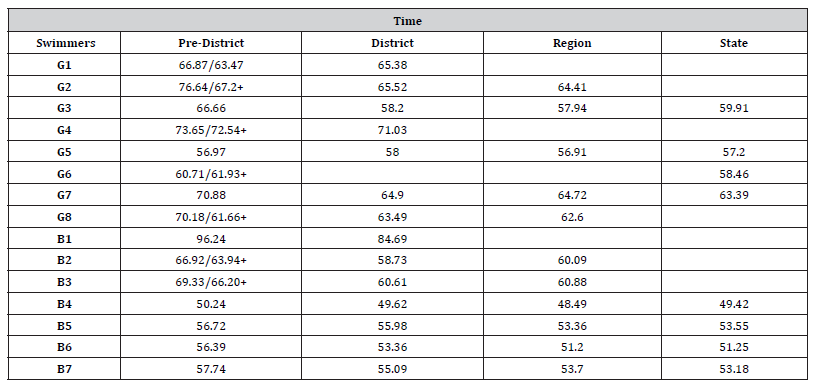
Table 3:Breakdown of Summary Competitions for 50-Yard Freestyle.
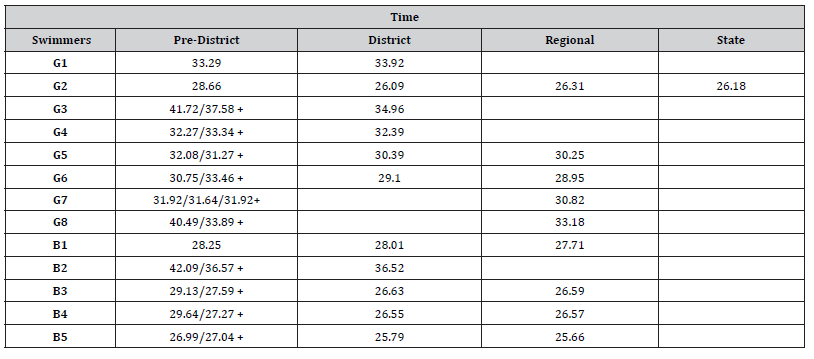
200-Yard Freestyle Swimmer Performance
The data obtained from the 2021-2022 swimming season for the 200-yard freestyle event corresponds to eight different swimmers. There are four girls and four boys; each swimmer performed this event four times, thus giving a total of 32 observations for analysis as Figure 1.
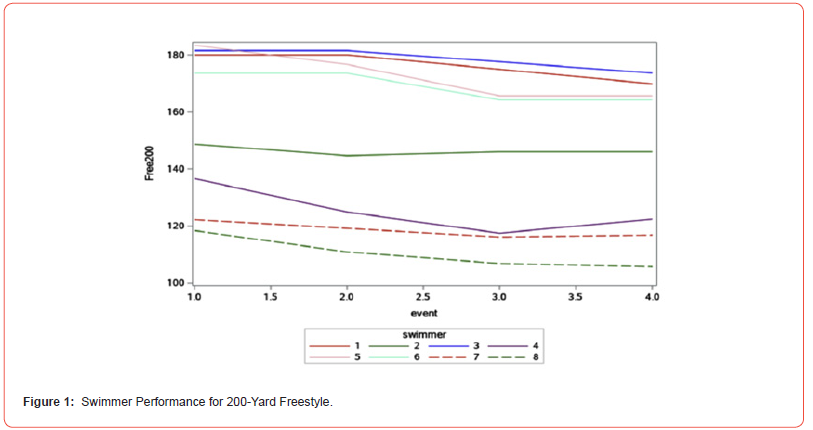
Note: [19-21], Pharr-San-Juan-Alamo ISD Stadium. (2021), [22- 24], UIL Texas. (2022).
The vertical axis in Figure 1 represents the time performed by the athlete and that of the horizontal axis represents the four events (pre-district meet, district meet, regional meet, and state meet). The data for the analysis associated with all the times for each swimmer. If the line is decreasing, there is an improvement in their speed. If the line is increasing, there is no improvement in their speed. The lines are drawn from left to right.
Note: [19-21], Pharr-San-Juan-Alamo ISD Stadium. (2021), [22- 24], UIL Texas. (2022).
Figure 2 is the output of statistical analysis that provides the mean form the 32 observations. the mean from the 32 observations to be 149.7 seconds, which is equivalent to two minutes, twentynine seconds, and seven milliseconds. The maximum corresponding to the slower time is 183.3 seconds, which is equivalent to three minutes, three seconds, and three milliseconds. The fastest time is one minute, forty-five seconds, and eight milliseconds with a standard deviation of twenty-seven seconds and nineteen milliseconds. The t-value for the 200-yard freestyle event is 20.74 where Pr>|t| is less than 0.0001. This means that there was a difference in time for the swimmer. They did improve on their time from pre-district to the championship meets.
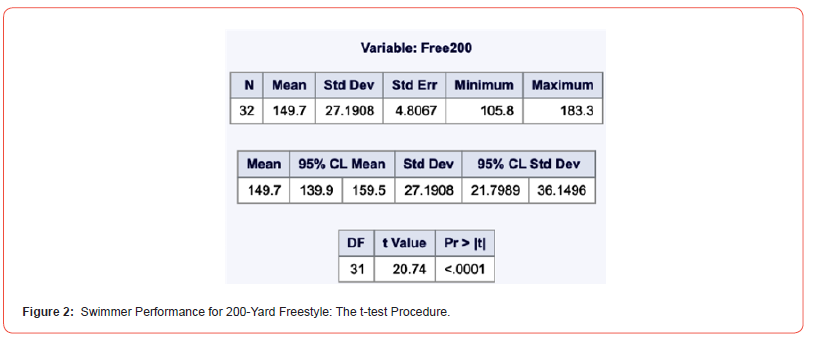
Note: [19-21], Pharr-San-Juan-Alamo ISD Stadium. (2021), [22- 24], UIL Texas. (2022).
Figure 3, the output of statistical analysis, indicates that the Pr >F was equal to 0.0004, which is still less than the alpha that is equal to 0.05 to conclude that there was a significant difference. The difference for linear regression means an improvement in the swimmers for the 200-yard freestyle.
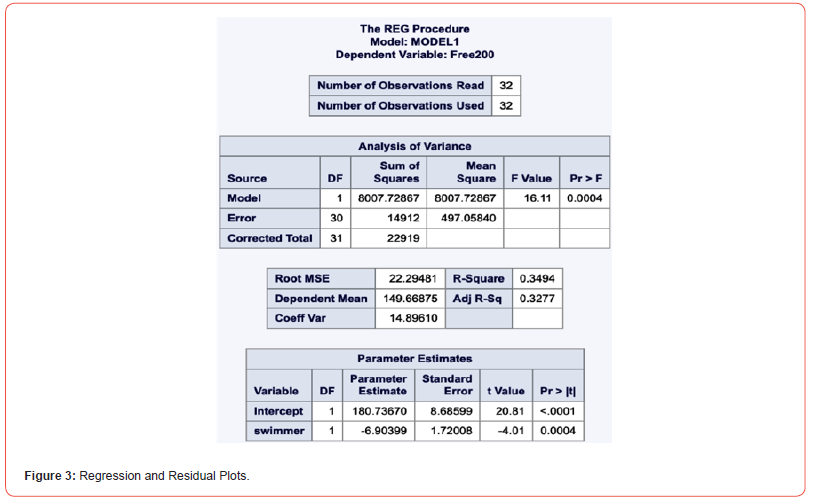
Note: [19-21], Pharr-San-Juan-Alamo ISD Stadium. (2021), [22- 24], UIL Texas. (2022).
Figure 4, the output of SAS statistical analysis, depicts that the 95% confidence limits would be narrowing down half the way before it began expanding again. A feature has been observed throughout all competitions.
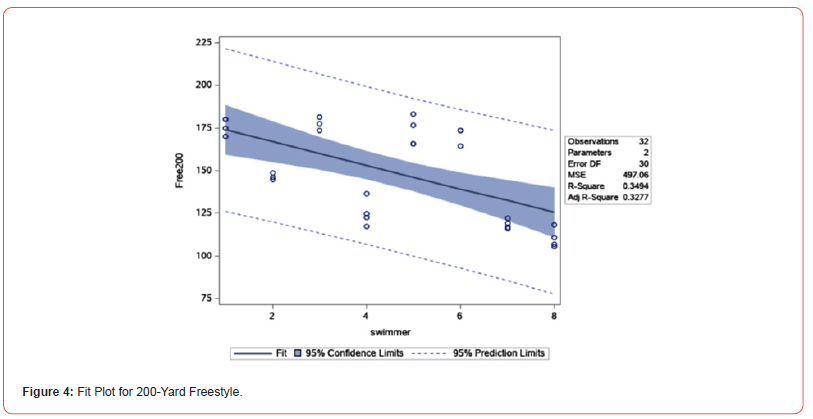
Note: [19-21], Pharr-San-Juan-Alamo ISD Stadium. (2021), [22- 24], UIL Texas. (2022).
In row 1 of Figure 5, the residual plots for the 200-yard freestyle show an adequate symmetry for the regression analysis to proceed, developing a regression analysis that the model is linear; error terms are independent and have constant variances. The other five methods involved various ways of including or excluding variables from the model from collinearity diagnostics. However, the data generated a mean squared error of 497.06, the R-square of 0.3494 and the adjusted R-square of 0.3277 to conclude that they are somewhat weakly correlated.

100-Yard Freestyle Swimmer Performance

The data obtained from the 2021-2022 swimming season for the 100-yard freestyle corresponds to fifteen different swimmers: Eight girls and seven boys. Each swimmer, except for four, performed the event four times, thus giving a total of 60 observations used for the analysis in Figure 6. The four swimmers that did not do it four times, their times have been repeatedly entered in the SAS code for completeness and subsequent programming.
Note: [19-21], Pharr-San-Juan-Alamo ISD Stadium. (2021), [22- 24], UIL Texas. (2022).
The vertical axis in Figure 6 represents the time performed by the athlete and the horizontal axis represents the four events (predistrict, district, regionals, and state). The data analysis connected all the times for each swimmer. If the line is decreasing, there is an improvement in their speed. If the line is increasing, there is no improvement in their speed, thus shortening the swimming times gradually. The lines are drawn from left to right.
Note: [19-21], Pharr-San-Juan-Alamo ISD Stadium. (2021), [22- 24], UIL Texas. (2022).
The mean from the 60 observations in Figure 7 is 62.8687 seconds, which is equivalent to one minute, two seconds, and eightyseven milliseconds. The maximum corresponding to the slower time is 96.24 seconds, which is equivalent to one minute, thirty-six seconds, and twenty-four milliseconds. The fastest time in the 100- yard freestyle is forty-eight seconds and forty-nine milliseconds with a standard deviation of ten seconds and five milliseconds. The t-value for the 100-yard freestyle event is 9.92 where Pr>|t| is less than 0.0001. This means that there was a difference in time for the swimmer. The mean significant difference in the data showed an improvement or change in time among the swimmers.
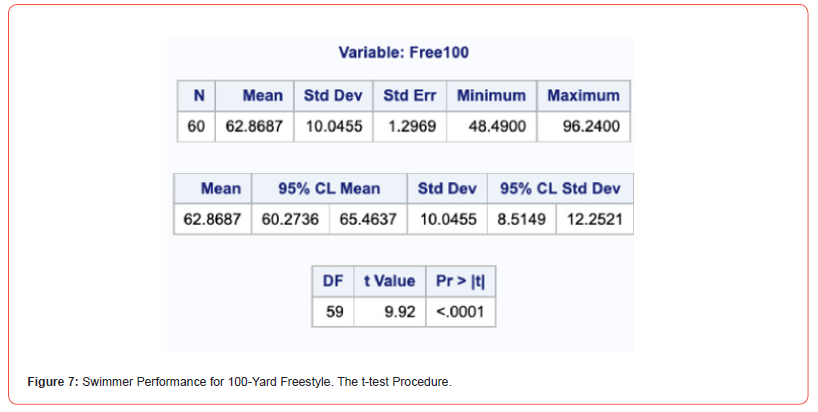
Note: [19-21], Pharr-San-Juan-Alamo ISD Stadium. (2021), [22- 24], UIL Texas. (2022).
The Pr >F was equal to 0.0034 in Figure 8, which is still less than the alpha that is equal to 0.05 to conclude that there was a significant difference. The difference for linear regression means an improvement in the swimmers for the 100-yard freestyle.
Note: [19-21], Pharr-San-Juan-Alamo ISD Stadium. (2021), [22- 24], UIL Texas. (2022).
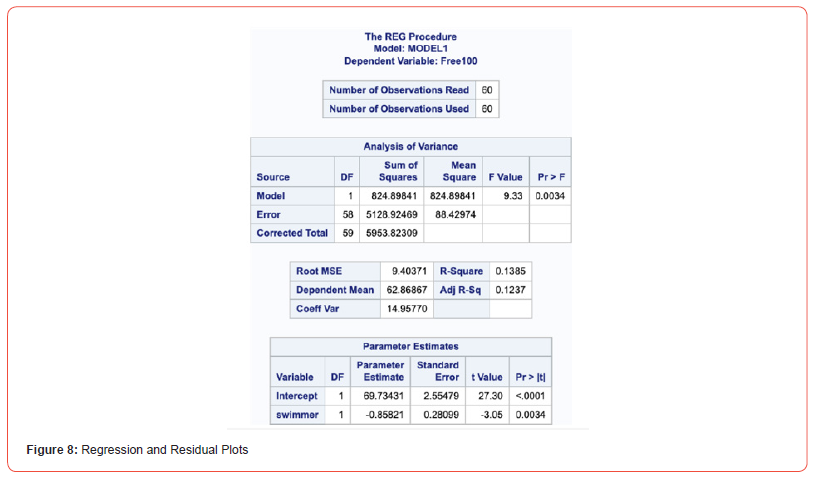
The output of SAS statistical analysis, provided in Figure 9 depicts that the 95% confidence limits would be narrowing down half the way before it began expanding, a feature that has been observed throughout all competitions.
Note: [19-21], Pharr-San-Juan-Alamo ISD Stadium. (2021), [22- 24], UIL Texas. (2022).
The row 1 of Figure 10, the residual plots for the 100-yard freestyle are not symmetric for the regression analysis to proceed any further, this developing a regression analysis that the model would be linear; error terms are independent and have constant variances. The other five methods involved various ways of including or excluding variables from the model from collinearity diagnostics. The data generated a mean squared error of 88.43, the R-Square of 0.1385 and the adjusted R-square of 0.1237.
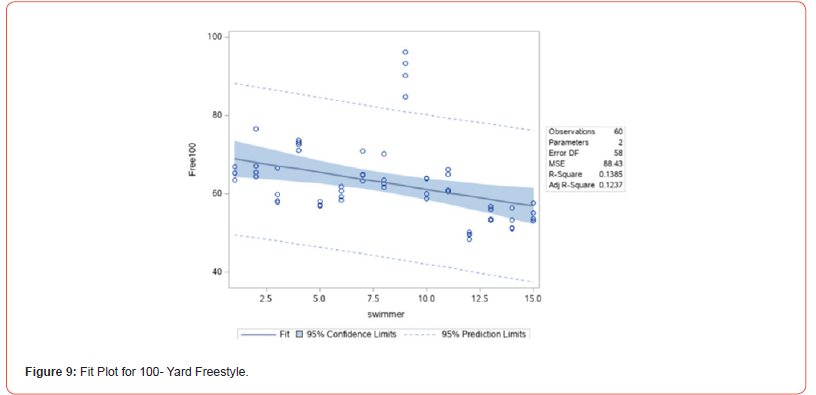
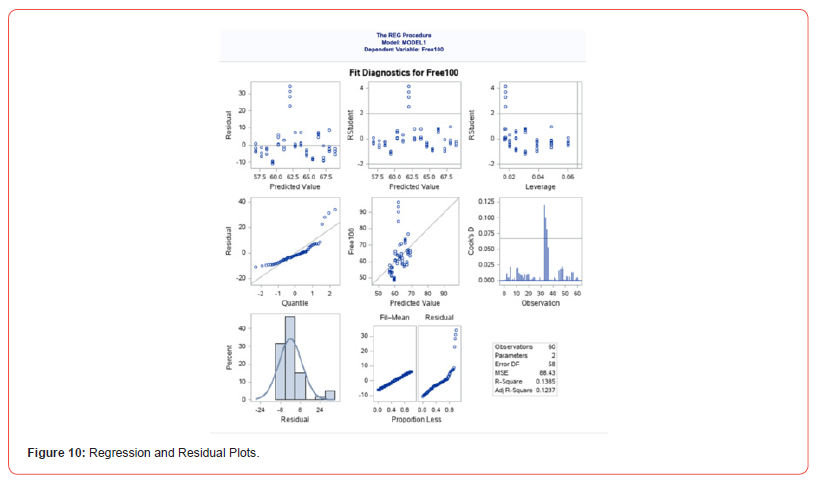
50-Yard Freestyle Swimmer Performance
Note: [19-21], Pharr-San-Juan-Alamo ISD Stadium. (2021), [22- 24], UIL Texas. (2022).
The vertical axis in Figure 11 represents the time performed by the athlete and the horizontal axis represents the four events (pre-district meets, district meet, regional meet, and state meet, respectively). The statistical analysis connected all the times for each swimmer. If the line is decreasing, there is an improvement in their speed. If the line is increasing, there is no improvement in their speed. The lines are plotted from left to right.

Note: [19-21], Pharr-San-Juan-Alamo ISD Stadium. (2021), [22- 24], UIL Texas. (2022).
Figure 12 corresponds to the mean from the 52 observations is 31.4452 seconds. The maximum corresponding to the slower time is 42.09 seconds. The fastest time is twenty-five seconds and sixty-six milliseconds with a standard deviation of 4.4719. The t-value for the 50-yard freestyle event is 29.92 where Pr>|t| is less than 0.0001. This means that there was a difference in time for the swimmer. They did improve on their time from pre-district to the championship meets.
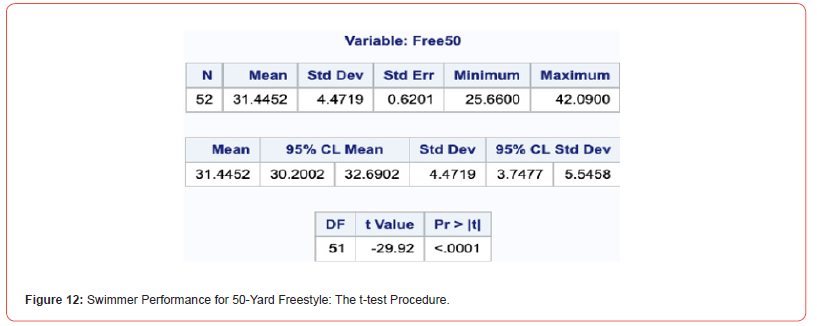
Note: [19-21], Pharr-San-Juan-Alamo ISD Stadium. (2021), [22- 24], UIL Texas. (2022).
The Pr > F was equal to 0.0327, which is still less than the alpha that is equal to 0.05 as in Figure 13 suggests that there was a significant difference. The difference for linear regression means an improvement in the swimmers for the 50-yard freestyle.

Note: [19-21], Pharr-San-Juan-Alamo ISD Stadium. (2021), [22- 24], UIL Texas. (2022).
Figure 14, a SAS statistical analysis output, depicts that the 95% confidence limits would be narrowing down half the way before it began expanding. A feature has been observed in all competitions thus far.

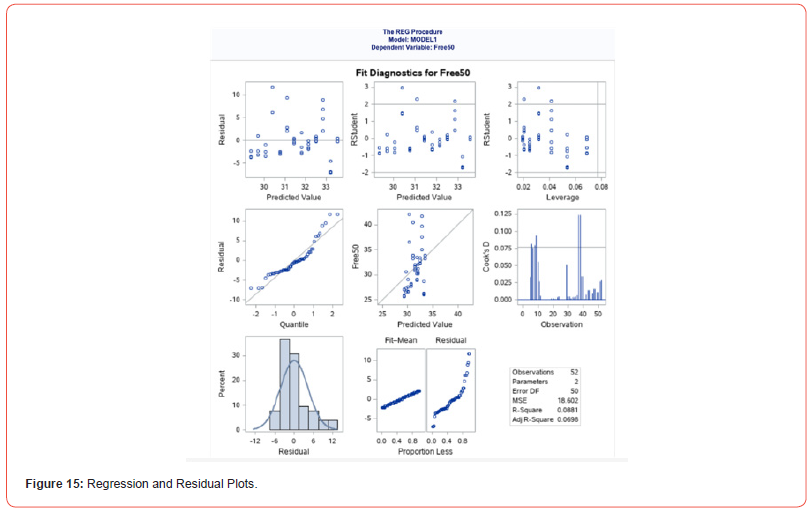
Note: [19-21], Pharr-San-Juan-Alamo ISD Stadium. (2021), [22- 24], UIL Texas. (2022).
Row 1 of Figure 15 is the residual plots for the 50-yard freestyle allows the symmetry for the regression analysis to proceed, this developing a regression analysis that the model is linear; error terms are independent and have constant variances. The other five methods involved various ways of including or excluding variables from the model from collinearity diagnostics. The data generated a mean squared error of 18.602, the R-square of 0.0881, and the adjusted R-square of 0.0698. The law MSE 18.602 as difference from Figures 5 and 10 means that the 50-yard freestyle even have a higher correlation with the index due to the standard deviation is only four seconds. The Pr > F was equal to 0.0327. It was close to the alpha mark, but it was less than 0.05. Mostly all the swimmers perform the same time speed and others have almost the same time in the four events (pre-district meets, district meet, regional meet, and state meet).
Conclusion
Throughout the season, the swimmers would swim their laps as training. The most yardage the swimmers would do in a practice is four thousand eight hundred yards to five thousand yards. There were no drylands during the high school practices. Out of the twentyeight swimmers, ten swimmers would swim in a private club after school. Some swimmers had a small increase in time between predistrict and district. There are many reasons as to why this could have happened. Between the months of November through January in the year, COVID was affecting everybody. Swimmers were getting sick with COVID or suffering from other illnesses. The data showed an increase or decrease in time between district, regional, and state competitions. During the weeks of district, regional, and state competitions, the swimmers were swimming at most two thousand eight hundred yards. That was the result of the taper workouts.
In conclusion, the study has demonstrated that the swimmers did decrease in time from the pre district meets to the championship meets. The training, hard work, and dedication paid off in the end.
Acknowledgement
The first author undertook preliminary research of this case study during the coursework of STAT 5390-290 Case Seminar in Applied Statistics in Spring 2022 and continued the project for the completion at the direction of Dr. Rohitha Goonatilake at Texas A&M International University (TAMIU), Laredo, Texas. The authors would like to thank the TAMIU Department of Mathematics and Physics, which includes Ms. Selina B. Balderas, Dr. Norma Saikali, and Dr. Saqib Hussain for their help and guidance in creating the necessary SAS codes for the analyses. The first author would also like to thank her parents, siblings, Ricky, family, and friends for being her number one fans, in and out of the pool. Her words of gratitude for the family, thank you for your endless love and support throughout my life. This one is for you: to the 2021-2022 United High School swimming and diving team and parents, thank you for all your hard work and dedication during the season. The first author is proud of her student-athletes and the accomplishments that they made this season. This season was a history-making as United High School had its first ever diving team to compete at the UIL district and regional meet, successively.
Conflict of Interest
None.
References
- Britannica T. Editors of Encyclopedia (2021, August 31) swimming. Encyclopedia Britannica.
- USA Swimming (2022) Overview: About USA swimming. Retrieved May 1, 2022.
- Swim America Program (2021) Award of Achievement. [Data Set].
- Pelayo P, Alberty M (2011) The History of Swimming Research, x-xxvi. Pharr-San-Juan-Alamo ISD Stadium. (2021). PSJA ISD vs Laredo United- 10/13/2021 Results [Data set].
- Berukoff K D, Hill G M (2010) A study of factors that influence the swimming performance of Hispanic high school students. International Journal of Aquatic Research and Education: Número 4: No. 4, Article 7.
- USA Swimming (2022) Dive in: Find a team & lessons. Retrieved May 1, 2022.
- Light R L, Lemonie Y (2010) A case study on children's reasons for joining and remaining in a French swimming club. Asian Journal of Exercise & Sports Science 7(1): 1-7.
- Majumder P P, Choudhury S R (2014) Reasons for success in competitive swimming among various human races. IOSR Journal of Sports and Physical Education (IOSR-JSPE) 1(3): 24-30.
- All American Swim TM (2022) TYR hexa durafast diamondfit. Retrieved May 1, 2022.
- All American Swim TM. (2022). TYR hexa curve splice jammer. Retrieved May 1, 2022.
- Montagna G, Catarino A, Carvalho H, Rocha A M (2009) Study and optimisation of swimming performance in swimsuits designed with seamless technology. AUTEX 2009 World Textile Conference pp. 33-39.
- Stefani R (2012) Olympic swimming gold: The suit or the swimmer in the suit? Significance 9(2): 13-17.
- Rushall B S, Sprigings E J (1994) A re-evaluation of forces in swimming, The Journal of Swimming Research 10: 6-10.
- Lee B W, Lee B J, Wong P C (2017) Effect of swim cap on heart rate on competitive high school swimmers. Harvard-Westlake Journal of Science 11: 28-31.
- Demarie S, Chirico E, Galvani C (2022) Prediction and analysis of Tokyo Olympic Games swimming results: Impact of the COVID-19 pandemic on swimmers’ performance. International Journal of Environmental Research and Public Health 19(4): 2110.
- Ramsi M, Swanik K A, Swanik C B, Straub S, Mattacola C (2004) Shoulder-rotator strength of high school swimmers over the course of a competitive season. Journal of Sport Rehabilitation 13(1): 9-18.
- Morouco P G, Almeida Marinho D, Amaro N M, Perez Turpin J A, Cardoso Marques M, et al. (2012) Effects of dry-land strength training on swimming performance: a brief review. Journal of Human Sport and Exercise 7(2): 553-559.
- Stewart A M, W G Hopkins (2000) Seasonal training and performance of competitive swimmers, Journal of Sports Sciences 18(11): 873-884.
- Margaret M. Clark Aquatic Center. (2021a) Halloween Hysteria 2021 - 10/29/2021 to 10/30/2021 Results [Data set].
- Margaret M. Clark Aquatic Center. (2021b) Pre-Regional Show Case 2021 - 12/10/2021 to 12/11/2021 Results [Data set].
- Margaret M. Clark Aquatic Center. (2022) 2022 Region VIII 6A - 1/31/2022 Results [Data set].
- UISD Aquatic Center (2021a) La COPA Laredo Invitational - 11/19/2021 to 11/20/2021 Results [Data set].
- UISD Aquatic Center (2021b) Laredo TISCA Championship - 12/17/2021 to 12/18/2021 Results [Data set].
- UISD Aquatic Center (2022) 2022 UIL Dist29-6A Swimming and Diving Champs - 1/29/2022 Results [Data set].
- Qiu X, Veiga S, Lorenzo A, Kibele A, Navarro E, et al. (2021) Differences in the key parameters of the individual versus relay swimming starts. Sports Biomechanics 16: 1-13.
- Pharr-San-Juan-Alamo ISD Stadium (2021) PSJA ISD vs Laredo United- 10/13/2021 Results [Data set].
- Texas (2022) 6A State Meet 2/18/2022-2/19/2022. [Data Set].
-
Sandra Alexis Duarte and Rohitha Goonatilake*. Training to be Champions: Swimming at the Helm - A Statistical Overview. Annal Biostat & Biomed Appli. 5(2): 2023. ABBA.MS.ID.000607.
Swimming, United High School swim team, District competition, Regional competition, State competition, Competitive swimming, Olympic Games, Swimming clubs, Interscholastic Swimming
-

This work is licensed under a Creative Commons Attribution-NonCommercial 4.0 International License.






